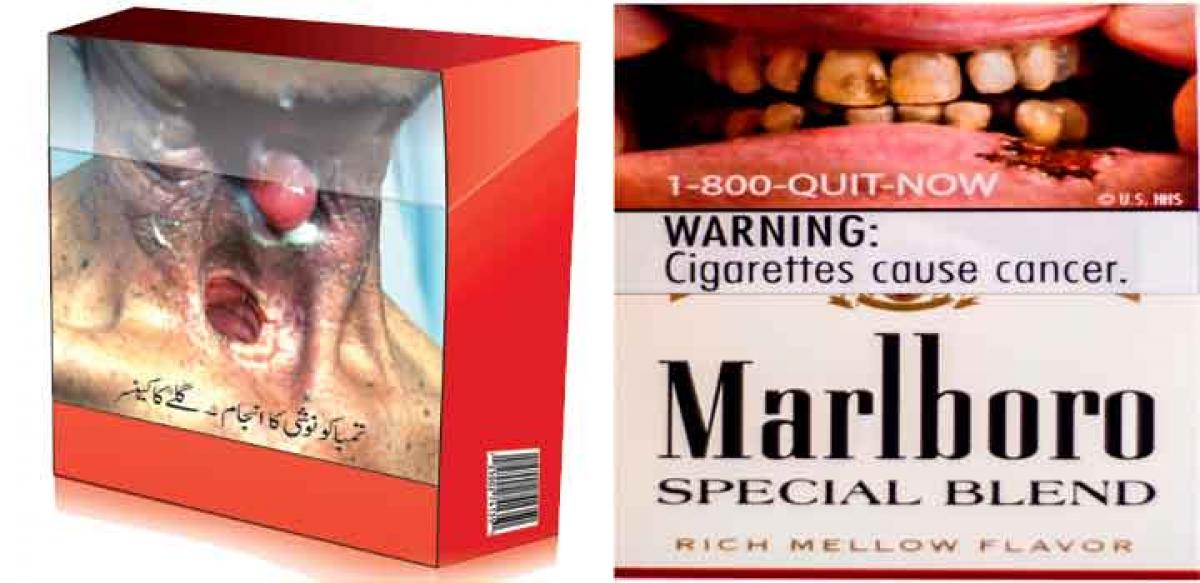Live
- Get Ready in Minutes with Wear and Go Wigs from RemyForte.com
- PM ‘cursing’ Congress out of despair: Maharashtra Cong Chief
- Applications are invited for Junior Colleges Scheme District Scheduled Castes Development Officer Ramlal
- A nomination was filed on the second day for the Nagar Kurnool parliamentary seat
- SP Gaikwad inspected the Telangana Amarnath Saleswaram Jatara yatra arrangements
- Rahul Gandhi's decision to contest from Wayanad shows 'lack of confidence': BJP President Nadda
- IPL 2024: Delhi bowlers will go after all of SRH’s top-order batters, says head coach Ricky Ponting
- At Amroha rally, PM Modi sends out ‘meaningful’ message for Muslims and Hindus
- Tripura records highest 79.83 pc voter turnout in Northeast
- The government has to clear the confusion
Just In
Will enlarged pictorial warnings reduce tobacco consumption?


Enlarged pictorial warnings on cigarette packets, showing frightening effects of tobacco consumption on health, may be a welcome step towards educating people about the perils of smoking, but this is still not enough to reduce the consumption rate among the majority of habitual smokers, say stakeholders and experts.
Enlarged pictorial warnings on cigarette packets, showing frightening effects of tobacco consumption on health, may be a welcome step towards educating people about the perils of smoking, but this is still not enough to reduce the consumption rate among the majority of habitual smokers, say stakeholders and experts.
The Supreme Court recently ordered cigarette producers to comply with the Health Ministry's new regulation mandating an increase in the size of the pictorial warning to 85 per cent of the front and back panels of cigarette packets.However, many regular smokers who don't buy full packets admitted that they are unaware about the order.
"I have not seen the enlarged warnings as I don't buy packets, but one or two cigarettes at a time," said Vikash Shaw from Kolkata, who smokes about eight cigarettes each day. Leading cigarette producer ITC has retained the prices of most of its brands but reduced the stick sizes to overcome the 10-15 per cent hike in tobacco taxes that was announced in this year's union budget.
For World No Tobacco Day, which is on May 31, the WHO and the Secretariat of the WHO Framework Convention on Tobacco Control are calling countries to get ready for plain (standardised) packaging of tobacco products.
Plain packaging is an important demand reduction measure that reduces the attractiveness of tobacco products, restricts use of packaging as a form of advertising and promotion, limits misleading labelling, and increases the effectiveness of health warnings.
Plain packaging of tobacco products refers to measures that restrict or prohibit the use of logos, colours, brand images or promotional information on packaging other than brand names and product names displayed in a standard colour and font style.
Serviceman Amitava Bhatacharya from Kolkata said that although initially the enlarged warning looked scary, it could not stop him from smoking. "When I first saw that big warning image, I was indeed terrified. But eventually I surrendered to my addiction," Bhattacharya told.
However, cigarette producers like ITC, Godfrey Phillips and VST Industries have complained that India's legal cigarette industry is facing a continuous drop in demand because of high taxation and large pictorial warnings. Dhaneswar Patra, a roadside paan-waala from Kolkata, told: "Even before these warnings were printed on the packets, smokers knew that it is harmful. But still they consumed cigarette at their own will. The same is happening now too."
On the other hand, doctors and economists are giving thumbs up to the new regulations. With almost one million people dying due to direct and passive smoking in India, medico SK Paira believed quitting tobacco is comparatively easier than other addictions.
"Smoking creates mental dependency while alcohol and drugs create physical dependency in which withdrawal symptoms are fatal. Mental determination is the best way to give up smoking," Paira told.
Praising the Health and Family Welfare Ministry's decree to print bigger and more disturbing warning on cigarette packets, economist Santanu Mitra told: "The enlarged warning may serve as a discouraging factor for first time smokers and those who are not regular or habituated smokers."

© 2024 Hyderabad Media House Limited/The Hans India. All rights reserved. Powered by hocalwire.com






